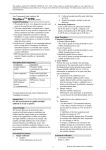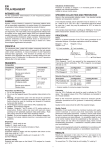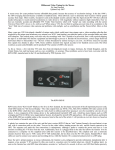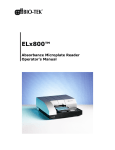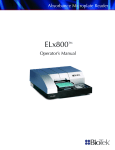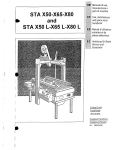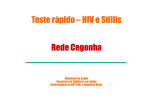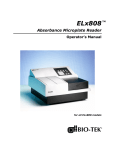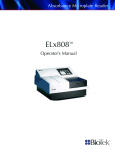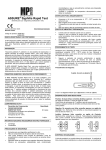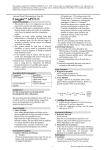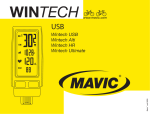Download Internal Information Sheet
Transcript
This product marketed by SEKISUI MEDICAL CO., LTD., Tokyo, Japan is manufactured subject to our supervision as stipulated in the Pharmaceutical Affairs Law of Japan and is allowed to be sold in Japan. For details, please contact us or your local distributors. bubble formation prior to use. 2. Assay Method Perform the assay according to the operating instructions for each automated analyzer. Refer to the Methodology Sheet for detailed assay methods. Contact SEKISUI MEDICAL CO., LTD. for information on parameters to be used with other types of analyzers. 1) Preparation of calibration curve Mix standard serum (*), sample dilution buffer and latex suspension to start the reaction. Prepare a calibration curve based on a difference in turbidities at predetermined times. Treponema Antibody Kit Mediace™ TPLA General Precautions 1. This product is for in vitro diagnostic use only, and must not be used for any other purposes. 2. Clinicians should make a comprehensive clinical decision based on assay results in conjunction with clinical symptoms and other examination results 3. This product should be used only as directed. Reliability of values cannot be guaranteed if this product is used for purposes or tested by methods other than those stated. 4. Read the user’s manual of your automated analyzer prior to using this kit. Parameters for different automated analyzers are available upon request. Analyzers should be cleaned before use to ensure accurate calibration. (*) Standard serum is sold separately. 2) Sample Analysis Measure turbidity changes by following the same procedure as described in ”Preparation of calibration curve”, and calculate anti-treponema antibody titer based on the calibration curve. 3) Parameters (for the Hitachi 7170 automated analyzer) 1. Mix 175 μL of sample dilution buffer and 16 μL of sample and incubate the mixture at 37°C for about 5 minutes. 2. Add 25 μL of latex suspension and incubate mixture at 37°C. 3. Measure turbidity changes from 50 seconds to 4 minutes at 700 nm. 4. Prepare a calibration curve based on the turbidity changes in standard serum by following the same procedure as above, and calculate anti-treponema antibody titer based on the turbidity changes. Descriptions (Kit Components) Component Sample dilution buffer Latex suspension Ingredients Phosphate buffer containing bovine serum albumin Treponema pallidum antibody-coated latex Intended Use For the measurement of anti-treponema antibody in serum Assay Principle The reaction between the treponema pallidum antibody-coated latex and anti-treponema antibody in sample occurs agglutination under given conditions. The anti-treponema antibody titer is calculated on the difference in pre- and post-reaction turbidities resulting from agglutination. Assessment of Results 1. Assessment of Results Positive: >10 T.U. T.U. is the abbreviation of TITER UNITS for anti-treponema antibody. 1 T.U. equals 2 mIU with WHO reference material. 2. Procedural Precautions 1. Sample Collection 1) Serum can be used. 2) Collected sample should be used while they are fresh. 3) Samples should be handled carefully to prevent infection. 2. Interfering Substances Assay results will not be affected by bilirubin (up to 20 mg/dL), hemoglobin (up to 1500 mg/dL), and rheumatoid factor (up to 1800 IU/mL). 3. 4. Assay Procedures 1. Reagent Preparation 1) Sample Dilution Buffer Mix well by gently inverting the bottle to avoid bubble formation prior to use. 2) Latex Suspension Mix well by gently inverting the bottle to avoid 5. 6. 1 When results come out positive, run subsequent tests and make a decision taking in consideration other examination results and clinical symptoms Clinicians should make a comprehensive clinical decision based on assay results in conjunction with clinical symptoms and other examination results. Do not make a diagnosis based on results obtained from this kit alone. Serum collected from patients in the early stage of anti-treponema antibody production or with decreased antibody producing ability due to compromised immune function may test negative. A non-specific immune reaction may occur in serum samples from patients with autoimmune diseases. Serum samples from patients receiving blood products containing immunoglobulin may test positive. Evaluate test results carefully. Revised: (Apr.) 2008 (1st edition) This product marketed by SEKISUI MEDICAL CO., LTD., Tokyo, Japan is manufactured subject to our supervision as stipulated in the Pharmaceutical Affairs Law of Japan and is allowed to be sold in Japan. For details, please contact us or your local distributors. 7. testing. Do not use the reagent if the label has been peeled off or if the label is smudged and illegible. 3. Precautions for Disposal 1) To avoid infection from HIV, HBV or HCV, waste fluid and instruments should be disinfected with sodium hypochlorite (effective chlorine concentration, 1000 ppm; immerse for over 1 hour) or with glutaraldehyde (2%, for over 1 hour) or sterilized with an autoclave (at 121°C for 20 minutes). 2) The reagent contains sodium azide. Sodium azide may react with lead or steel pipes and produce highly explosive metallic azide. When disposing reagents, flush out with copious amounts of water. 3) The reagents should be disposed in accordance with water pollution control regulations or related regulations. Keep in mind that the prozone phenomenon (which is associated with immune response) may affect results. Performance 1. Performance The performance when used in accordance with standard testing method is described below. 1) Sensitivity (1) Turbidity change in a normal human serum (syphilis negative): < 0.01. (2) Turbidity change in a positive control serum of around 450 T.U.: 0.10 - 0.70 2) Accuracy (1) Positive control serum at given concentration is always 10 T.U. or higher. Negative control serum at given concentration is always 10 T.U. or less. 3) Within-run Reproducibility Coefficient of variation 15% (Assay of 10 replicates using a positive control serum of a known concentration) 4) Measurement Range (on the Hitachi7170 automated analyzer) 5 - 250 T.U.2) For samples exceeding 250 T.U., dilute with antibody negative serum prior to testing. 2. Correlation N=171, r = 0.828, y = 1.06x + 10.5 Reference method: TPHA (other manufacturer)1)2). Storage and Shelf Life 1. Storage temperature: 2 - 8°C (avoid freezing). 2. Shelf life: 1 year from the date of manufacture (The expiration date is printed on the outside of the package.) Package Contents 1. Mediace™ TPLA (A) Description Sample Dilution Buffer Latex Suspension 2. Mediace™ TPLA (M) Description Sample Dilution Buffer Latex Suspension Precautions and Warnings 1. Handling Precautions 1) All samples used in the test should be handled as if potentially infectious for HIV, HBV and HCV. To prevent infection, use disposable gloves and avoid mouth pipetting during the test. 2) Do not eat, smoke, apply cosmetics or touch contact lenses in the testing area where samples and reagents are handled. 3) The sample dilution buffer and the latex suspension contain sodium azide at a concentration of 0.1% or lower as a preservative. If the reagent accidently comes into contact with the eyes or skin, immediately and thoroughly rinse the area with water and seek medical treatment if necessary. 2. Precautions for Use 1) This product should be stored as directed. Avoid freezing. Do not use the product if it has frozen, stored under conditions other than those specified, or has expired. 2) Do not mix sample dilution buffer and latex suspension of different lots. 3) Prepare a calibration curve for every testing. Do not change the bottles and lots of sample dilution buffer or latex suspension during testing. 4) Use the thermostat of analyzer to keep reaction temperature constant. 5) Check the reagent bottle and its label before Configuration 18 mL x 4 10 mL x 1 Configuration 49 mL x 2 14 mL x 1 References 1) Kazuhisa Osato et al. Clinical Evaluation of Reagents for Latex Agglutination Test for Anticardiolipin Antibody and Anti-TP Antibody; Journal of Japanese Society for Sexually Transmitted Diseases 13; 124-130, 2002 2) SEKISUI MEDICAL CO., LTD. In-house data Marketing Authorization Holder SEKISUI MEDICAL CO.,LTD. 13-5, Nihonbashi 3-chome, Chuo-ku, Tokyo, Japan [email protected] "Mediace" is a trademark owned by SEKISUI MEDICAL CO.,LTD. JAPAN, and is registered in Japan and/or other countries. 2 Revised: (Apr.) 2008 (1st edition)


